Source: Journal of Geophysical Research: Planets
When water ice—one of the most ubiquitous and important solids found on icy celestial bodies—is exposed to high levels of radiation, it dissociates into hydrogen, oxygen, peroxide (H2O2), and other products that contribute directly to the composition of each satellite’s surface and, via sputtering, its outer atmosphere. Although this dissociation commonly occurs on icy satellites, laboratory experiments have produced oxygen yields spanning more than 4 orders of magnitude. This makes it challenging for current models to accurately predict the composition of products that result from different kinds of radiation or to quantitatively evaluate the effect on the surface and atmospheric composition of a celestial body.
To solve this longstanding conundrum, Teolis et al. have revisited decades’ worth of published data to develop an analytical model of ice dissociation on celestial bodies that is consistent with all laboratory measurements. Their results show that for highly penetrating forms of radiation, the volume of synthesized oxygen is directly related to the depth at which each particle penetrates the icy body’s surface. The same relationship, however, does not hold true for peroxide, leading the authors to conclude that oxygen and hydrogen are preferentially generated in an extremely thin layer near the ice surface, whereas peroxide can be synthesized with equal efficiency at all depths along each particle’s track.
By integrating the effects of various types of radiation over a range of temperatures, the new model offers a useful tool for predicting the products of the dissociation of pure water ice by radiation of any energy or ion mass. It also offers an opportunity to predict the quantity of ice dissociation products expelled into an icy satellite’s atmosphere and to compare these experimentally derived forecasts with spacecraft measurements to directly quantify an icy body’s surface composition. (Journal of Geophysical Research: Planets, https://doi.org/10.1002/2017JE005285, 2017)
—Terri Cook, Freelance Writer
Citation:
Cook, T. (2018), A consistent model of ice dissociation on celestial bodies, Eos, 99, https://doi.org/10.1029/2018EO098395. Published on 14 May 2018.
Text © 2018. The authors. CC BY-NC-ND 3.0
Except where otherwise noted, images are subject to copyright. Any reuse without express permission from the copyright owner is prohibited.

